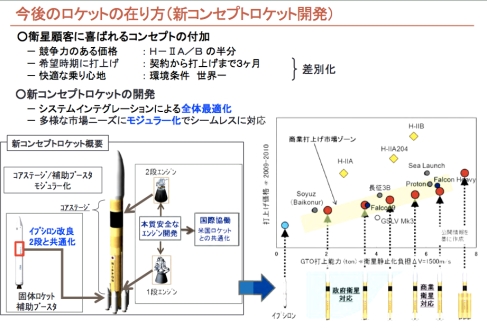Key Japanese Sub-committee Recommends Development of H-2A replacement
The Space Transportation Systems Subcommittee ( 宇宙政策委員会 宇宙輸送システム部会) of the Office of National Space Policy (ONSP) May 17 made a provisional recommendation that Japan develop a successor to Japan’s H-2A main launch vehicle.
The Japanese media has been all over this with the Nikkei “breaking” the “story” earlier in the week. Actually as one of its first actions on its establishment and first meeting on March 28, the committee publicized its schedule and Friday’s sort of pre-decision ( 中間とりまとめの方向の審議) comes before the final decision next month.
Notice of the recommendation will be placed on the ONSP’s website early next week but the ONSP sub-committee had made a recommendation that Japan develop a successor to the H-2A, a liquid propelled two-stage medium launch vehicle that is bought from the Japanese government from Mitsubishi Heavy Industries, Ltd. (MHI) of Tokyo.
Here is what the Japanese Media is saying about it. As it’s quasi-governmental, the NHK’s version of reality is probably close to the mark:
開発の方針が決まったH3ロケットは、液体燃料を使ったメーンエンジンに、固体燃料の補助エンジンを組み合わせるなどして飛ばす大型ロケットで、17年前、開発に着手したH2Aの後継機です。現在、およそ100億円かかっている打ち上げ費用を、50億円から65億円程度に大幅に削減する計画で、2020年度に1号機の打ち上げを目指しています。宇宙政策委員会の部会は、このH3の開発を今月中にも正式決定し、来年度予算の概算要求に研究開発費を盛り込む予定です。開発にかかる最終的な金額は、およそ2000億円と見込まれています。
The long and short of it is that development will start from next year for a replacement for the H-2A with a target launch cost ranging from $50-65 million (@100¥ to the dollar) about half today’s H-2A launch cost; first flight in 2020 and total development cost to be held to 200 billion yen.
The Transportation Systems Sub-committee is responsible within the ONSP for Japan’s launch vehicle development policy based on the second 5-year Basic Plan for Space Policy set by ONSP. The Basic Plan, released February 25 this year, which comes into effect this March, emphasizes that that Japan focus its development on developing the solid-fuel Epsilon launch vehicle together with a “cost effective” successor to the H-2A, according to sub-committee documents and the remit provided by the Basic Plan.
In a briefing titled “Evaluation of Present Mainstay Rocket Systems and Future Systems Development Methodology” (PKK translation) submitted April 24 to the sub-committee by MHI Executive Vice President and Head of Aerospace Systems Yoichi Kujirai, MHI has proposed a two-stage “New Concept Rocket” (see picture above) design based on a liquid fueled core stage supplemented by solid rocket booster augments based on the second stage of the Epsilon launch vehicle that would be ready for commercial competition in 2020 at a price tag half the price of the current H-2A, according to the briefing documents.
MHI had formerly proposed an H-X (or H-3), whose first stage was supposed to use an LE-X engine with a high-thrust expander bleed cycle which was originally for up to three test launches starting 2018. However the design met with considerable doubts in the ONSP about its cost and commercial viability. It is unclear at time of writing how the “New Concept Rocket” differs from prior H-3/X concepts.
According to its meeting publicly available meeting schedule, the sub-committee is due to make its final decision by the end of June. A development budget, final design parameters and budget will accompany the final decision.

